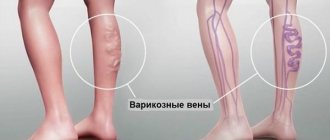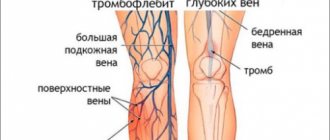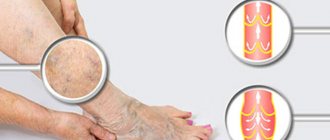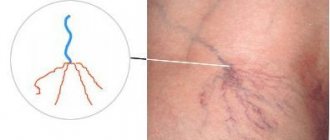Perineal varicose veins are varicose veins in the perineal area (varicose veins of the labia, varicose veins of the perineum), developing due to obstruction of venous outflow. Varicose veins of the labia are a manifestation of impaired outflow through the system of internal iliac veins due to their blockage or compression. The mere presence of signs of varicose veins of the labia does not pose a threat to the patient’s life, but is aesthetically unacceptable for young women, complicates sexual life and may indicate serious circulatory disorders in the pelvis.
Predisposing factors in the development of genital varicose veins in women
Varicose veins on the labia have a genetic predisposition - the mechanism of the disease is similar to varicose veins of the lower extremities. The basis is dysfunction of the valves of the gonadal veins. Physical activity, frequent pregnancies, engorgement of the genital organs during prolonged sexual intercourse contribute to vascular stretching with the development of venous stagnation. The appearance of varicose veins of the labia during pregnancy usually occurs in the second trimester and reaches a maximum closer to childbirth. After childbirth, these varicose veins, which developed during pregnancy on the labia, most often regress, but sometimes remain for life due to changes in the structure of the vascular walls.
The main simple preventive measures are the following:
- Wear comfortable underwear;
- Limit physical activity, while performing simple exercises to keep fit, swimming
- Monitor your diet by adding more fiber to your diet
- Sufficient amount of liquid
- Walking in loose shoes, heels no more than 4 cm, comfortable, non-tight clothing
- Do not take hot baths, do not visit the bathhouse, sauna
- Daily ascending contrast shower
- Active motor mode, avoid prolonged stationary positions, walking for 2 hours
- Perform special venous exercises
- Watch your weight
- Sleep on your left side
- Wear compression stockings
- See a phlebologist
Considering all of the above, our advice for pregnant women with varicose veins:
- Wear compression stockings at all times throughout your pregnancy.
- maintain an active motor mode;
- see a phlebologist throughout pregnancy;
- strictly follow all recommendations of the specialist;
- If the first signs of deterioration occur, seek help immediately.
If you are planning a pregnancy and have varicose veins, have them operated on before pregnancy and protect yourself and your unborn child.
The article was prepared by a vascular surgeon of the highest category, phlebologist Vladimir Vladimirovich Gerasimov.
For information about treatment and to make an appointment, call contact: 044 495 2 888 or 097 495 2 888
Consultation with a phlebologist Prevention of varicose veins
Arteriovenous compression
- Aorto-mesenteric compression of the left renal vein
Aorto-mesenteric compression of the left renal vein (aorto-mesenteric “tweezers”, nutcracker syndrome, mesoaortic compression syndrome of the left renal vein) is a situation in which the left renal vein is compressed between the aorta and the superior mesenteric artery. This leads to disturbances in the outflow of blood in the left renal vein, expansion and formation of “reverse” blood flow through the left gonadal vein with the formation of symptoms of varicose veins of the female genital organs.
- May-Turner syndrome
May-Turner syndrome is a situation in which the left common iliac vein is compressed by the right common iliac artery, leading to expansion of the common iliac vein below the site of compression and overflow of the pelvic vessels with venous blood. We also often observe the development of varicose veins - expansion of the left lower limb, the formation of persistent swelling of the soft tissues of the left lower limb and even trophic disorders (pigmentation). Most often, with May-Turner syndrome, varicose veins on the outer labia develop during pregnancy and remain forever after pregnancy (photo).
- Postthrombotic disease
Quite often one can observe the development of pelvic varicose veins in patients who have previously suffered deep vein thrombosis (especially proximal thrombosis) when there is a residual narrowing of the lumen or complete occlusion of the lumen of the common iliac vein. In this case, the outflow of blood from the pelvic organs is sharply hampered and, as a consequence, the expansion of the lumen of blood vessels and the development of pelvic varicose veins.
- Venous dysplasia
This is a malformation of the superficial or deep veins that occurs in the early phases of the formation of the vascular system of the embryo in the period from 4 to 8 weeks of intrauterine development. Venous dysplasia leads to the appearance of varicose veins of the minor lips. The diagnosis of dysplasia can be established provided that other causes of dilation of the genital vessels are excluded. Dysplasias look like dense vascular spots that are difficult to empty when squeezed. They resemble tumor-like formations more than dilated varicose veins.
Vulvar and perineal varicose veins in pregnant women
Journal "Outpatient Surgery" No. 1-2, 2019
DOI: https://doi.org/10.21518/1995-1477-2019-1-2-14-18
Jenina O.V.
1, Ph.D., phlebologist, leading specialist,
Bogachev V.Yu.
1,2, Doctor of Medical Sciences, Professor of the Department of Faculty Surgery No. 2,
Bodanskaya A.L.
1, phlebologist, lymphologist
1 Limited Liability Company "First Phlebological Center"
2
Federal State Budgetary Educational Institution of Higher Education “Russian National Research Medical University named after N.I.
Pirogov" Pregnancy is an important specific risk factor for the development of chronic venous diseases in women. In addition to the superficial veins of the lower extremities, the transformation often affects the veins of the small pelvis. The tactics of managing pregnant women with dilated veins of the perineum and genitals is currently one of the pressing problems at the intersection of phlebology and obstetrics-gynecology. The article discusses possible options for conservative treatment of women with vulvar and perineal varicose veins during pregnancy, including a discussion of the possibility and feasibility of using systemic pharmacotherapy with venoactive drugs.
Vulvar and perineal varicose veins in pregnant women
Olga V. Dzhenina
1,
Vadim YU. Bogachev
1,2,
Antonina L. Bodanskaya
1
1 First Phlebological Center, Limited Liability Company, 2 Federal State Budgetary Educational Institution of Higher Education “Russian National Research Medical University named after NI Pirogov” of the Ministry of Health of the Russian Federation
Pregnancy is an important specific risk factor for the development of chronic vein diseases in women. In addition to the superficial veins of the lower limbs, transformation often affects the pelvic veins. The management of pregnant women with vulvar and perineal varicose veins is one of the urgent problems of nowadays at the intersection of phlebology and obstetrics-gynecology. The article discusses possible options for conservative treatment of women with vulvar and perineal varicose veins during pregnancy, including the possibility and feasibility of using systemic venoactive drugs.
One of the most significant risk factors for the development of chronic venous diseases (CVD) in women is pregnancy. The cause is physiological changes that occur in absolutely all pregnant women, begin to act from the earliest gestational stages and gradually increase their influence in parallel with the progression of pregnancy.
Among the prerequisites currently being considered are:
— hormonal
in the form of a progressive increase in the level of progesterone, which provokes the destruction of collagen and elastin fibers, leading to disruption of the architectonics of the venous wall and a decrease in the ability to maintain a constant diameter of the vessel; are implemented throughout the entire gestational period;
— mechanical
– an increase in the volume of circulating blood, intra-abdominal pressure and direct compression of the main veins of the small pelvis by the pregnant uterus, which together leads to an increase in intravenous pressure; become important in the II–III trimesters [1–3].
These predictors lead to the fact that even the first, uncomplicated pregnancy itself gives an odds ratio of at least 1.3 for varicose transformation, and with each subsequent pregnancy this indicator increases (Table 1). In cases where, in addition to pregnancy, a woman has additional risk factors for CVD - heredity, excess body weight, etc. - an additional increase in the odds ratio should be expected [4].
Table. The relationship between the number of pregnancies and varicose transformation [4]
| Number of pregnancies (B) | B = 1 | B = 2 | B = 3 | B = 4 | B ≥5 |
| Odds ratio | 1,3 | 1,4 | 1,6 | 1,9 | 2,2 |
The venous bed of both the pelvis and the lower extremities is affected, while at first glance, varicose transformation of the superficial veins of the lower extremities is more common. The incidence of pelvic varicose veins during pregnancy has not yet been fully assessed. According to the literature, isolated dilatation of the veins of the perineum and genitals occurs in only 10–12% of pregnant women. At the same time, a number of experts suggest that a certain number of patients are not taken into account due to the lack of complaints from the women themselves: due to mild or absent subjective symptoms, shyness of patients, etc. [5–7].
The prevalence of gestation-related dilatation of intrapelvic veins is also not taken into account. First of all, this can be explained by the absence of any external manifestations that the patient could notice and eventually see a doctor. Secondly, there is a certain difficulty in assessing the clinical probability of pelvic congestion syndrome in such patients, since the most common manifestations - bursting pain in the lower abdomen, dysuric disorders - may be due to the peculiarities of the course of pregnancy.
Varicose veins of the perineum and genitals have objective manifestations that make it possible to diagnose this variant of venous pathology already during the initial examination, often without requiring mandatory instrumental confirmation. First of all, there is a direct expansion of the superficial veins with the appearance of aneurysmal protrusions-varixes on the labia, in the perineum. With a small volume, this is most often the woman’s only complaint. Subsequently, symptoms appear that can be regarded as similar to chronic venous insufficiency of the lower extremities: patients note bursting, pulling and pressing sensations in the perineum, bursting pain directly in the projection of varix. Many pregnant women note an increase in pain not only in situations standard for CVD - at the end of the day, under static loads - but also when changing body position (lying down/sitting down, sitting/standing up), tension in the muscles of the abdominal wall and pelvic floor. Also, the pain syndrome may be accompanied by dysuric symptoms, itching, and rarely, swelling of the perineum.
In cases where the source of reflux is not only the intrapelvic veins, but also v.saphena magna, dilatation of the veins in the inguinal areas is observed (with a small size of the varix, if it manifests itself only in orthostasis, this can be mistakenly regarded as an inguinal hernia), and also in the area of suprapubic flow [7].
Is instrumental examination required?
In most cases, examination is sufficient to make a diagnosis. An instrumental examination - angioscanning - is required if there is a clinical suspicion of thrombosis of the dilated superficial vein of the perineum/genitals, namely: a palpable painful compaction along the vein with a change in the color of the skin or mucous membrane above it. Ultrasound angioscanning is necessary to confirm a more dangerous condition - thrombosis - which requires completely different tactical approaches.
The second clinical situation in which it is advisable to conduct angioscanning, as well as ultrasound examination of soft tissues, is the differential diagnosis between a single varix in the groin area and an inguinal hernia.
What can we offer today to a pregnant woman who has been diagnosed with vulvar or perineal varicose veins?
The expert community currently considers pelvic varicose veins as one of the forms of CVD; accordingly, the basic principles of treatment apply to this pathology, although they require certain restrictions taking into account the location of the problem vein, and in pregnant women, taking into account the potential effects on the developing fetus.
Conservative treatment of CVD is based on elastic compression, systemic pharmacotherapy with venoactive drugs, local pharmacotherapy using topical heparin-based agents and venotonics, as well as lifestyle modification [8].
Elastic compression has long been a fundamental component of the conservative treatment of CVD. Thanks to medical compression hosiery and special bandages, pathological venous capacity is reduced, venous blood reflux and interstitial edema are eliminated, microcirculation in soft tissues is improved, etc. [9–11]. Thanks to this, even compression class 1 knitwear is effective in eliminating the subjective symptoms of CVD and venous edema [13–15].
However, all these therapeutic effects cannot be realized with isolated vulvar or perineal varicose veins, since not a single ready-made compression product, even special tights for pregnant women, puts pressure on the perineal area. The use of special compression garments, which are used after plastic surgery (such as abdominoplasty, liposuction, etc.), is contraindicated in pregnant women due to high pressure on the anterior abdominal wall, which can negatively affect the course of pregnancy itself.
The only situation in which regular wearing of compression products is justified is the simultaneous presence of CVD of the lower extremities.
The second main direction in the conservative treatment of chronic venous disease is systemic pharmacotherapy with phlebotropic drugs, the main goal of which is to reduce subjective manifestations and venous edema. Venotonics act through norepinephrine-dependent mechanisms and can additionally reduce leukocyte-endothelial adhesion and capillary permeability, stimulate lymphatic drainage, and reduce specific venous pain [8, 9, 16, 17]. One of the indications for the use of venotonics is varicose veins of the small pelvis with pain. But until recently, pregnancy was considered as a condition that limited the possibility of such pharmacotherapy.
There are several reasons for this:
- a small number of studies on the safety and effectiveness of venotonics during pregnancy; - reluctance to use essentially symptomatic treatment for a non-life-threatening condition in pregnant women, when it is necessary to take into account the potential effect of the active substance on the fetus; — underestimation of the prevalence of the problem and its impact on the quality of life of pregnant women.
Despite periodic reports of the use of venotonics for gestational dilatation of the vulvar veins [7], the opportunity to reconsider approaches to the use of phlebotropes in pregnant women was provided by the EFEMERIS epidemiological study, which assessed the possible direct and indirect effects of various pharmaceuticals not only on the development of the fetus, but also the course of pregnancy and delivery itself. [18]. The main group consisted of 8998 women who took diosmin, troxerutin and hesperdin during pregnancy, and some of them used repeated courses of venotonics. The control group included 27,962 pregnant women who did not take such drugs. Analysis of the course and outcomes of pregnancies showed the absence of a negative effect of the above venotonics on the course of pregnancy, delivery and the postpartum period, as well as fetal development.
Considering the encouraging results of EFEMERIS, the ineffectiveness of the routine use of elastic compression, the specific analgesic effect of modern phlebotropes, the use of diosmin-containing drugs in pregnant women with pain due to perineal/vulvar varicose veins seems justified and appropriate.
We have our own experience with the use of venoactive drugs: we observed 192 women with vulvar and perineal varicose veins during the second and third trimesters of pregnancy. Due to bursting pain in the perineum and along the varicose veins with an intensity ranging from 5 to 8 points on a ten-point numerical rating scale (Numeral Rating Scale, NRS), the patients received diosmin 600 mg/day. The duration of continuous use of diosmin ranged from 2 to 10 weeks, 11 patients underwent two courses of therapy (8 weeks each with an interval of 4 weeks between courses). Among 129 women with pain of moderate intensity (5-6 points according to NRS), 47.29% noted complete relief of pain, in other cases - a decrease in intensity by 2 points or more. In almost a third (27%) of 63 women with severe pain (5-6 points on NRS) while taking diosmin 600 mg/day, a decrease in its intensity by 2 points or more was recorded, but complete relief of pain in this subgroup was not achieved. None of the 192 patients had any complications of pregnancy, childbirth or the postpartum period that could be associated with taking venotonics. During vaginal birth, spontaneous rupture of varixes was not observed. There were no births of children with congenital malformations in these women who took diosmin at a dosage of 600 mg/day during pregnancy.
Russian guidelines for the treatment of CVD recommend an individual approach when prescribing venotonics in pregnant women, with an assessment of the ratio of expected benefits for the mother and potential effects on the fetus [8].
In contrast to systemic pharmacotherapy, the use of topical heparin-based agents or venotonics for vulvar or perineal varicose veins does not seem appropriate to us:
- distraction therapy, - short duration of effect, - peculiarity of the localization of problem veins, high probability of gel or ointment getting into the vaginal mucosa with a potential adverse reaction.
Lifestyle modification remains relevant for this category of patients.
It seems to us that the following emphasis is appropriate:
1.
prevention of additional increase in intra-abdominal pressure, i.e.
prevention of constipation: physical activity, balanced diet with vegetables, cereals, fiber, sufficient fluid intake; 2.
prevention of pathological weight gain;
3.
use of support bandages in consultation with an obstetrician-gynecologist.
What other features does the management of pregnant women with vulvar and perineal varicose veins have? Both the women themselves and the obstetrician-gynecologists observing them can contact a phlebologist to assess the possibility of vaginal birth. In the vast majority of cases, such localization of varicose veins does not affect delivery tactics. The risk of spontaneous rupture of varixes and, accordingly, the risk of bleeding during childbirth can only be represented by very large, tense (not compressed upon palpation) varixes that extend to the vaginal walls. In this case, delivery tactics are determined together with an obstetrician-gynecologist; when determining the high risk of large perinatal blood loss, one can think about the advantages of a planned cesarean section. It should be taken into account that in the prenatal period, even with a slight change in the position of the fetus in the uterus, varix can become relaxed and the risk of hemorrhagic complications will decrease [19].
In the early postpartum period, varicose veins of the perineum and genitals quickly regress in the vast majority of patients. Recurrences of this condition are usually associated only with repeat pregnancies. Even if complete regression does not occur, the volume of dilated veins and the associated discomfort are significantly reduced. In the future, residual vulvar/perineal varicose veins can be eliminated using miniphlebectomy or scleroobliteration.
conclusions
Isolated vulvar and perineal varicose veins are not a life-threatening condition, but the associated pain syndrome worries pregnant patients and leads to a certain decrease in quality of life. Yes, none of the forms of CVD can be completely eliminated with the help of conservative treatment, but the use of systemic pharmacotherapy can reduce subjective manifestations, including venous pain. This leads to an improvement in the quality of life of patients, which is especially significant in cases where radical surgical intervention is impossible for a number of reasons, including pregnancy. We see the advisability of more active use of modern diosmin-containing phlebotropes, which have proven the absence of negative effects on the course of pregnancy and fetal development, in pregnant women with varicose veins of the small pelvis in the event of the formation of a specific pain syndrome. Also, in our opinion, there is a need for further monitoring of such patients outside of pregnancy with planned elimination of residual dilated veins using minimally invasive methods (sclerotherapy, miniphlebectomy, laser thermoobliteration).
Sources
- International research program VEIN CONSULT. http:www.veinconsult.com.
- Savelyev V.S., Kirienko A.I., Bogachev V.Yu. Chronic venous diseases in the Russian Federation. Results of the international research program VEIN CONSULT. Phlebology. 2010;4(3):9-12.
- Krajcar Dz., Radaković B., Stefanić L. Acta Med Croatica. 1998;52(1):65-69.
- Bromen K., Pannier-Fischer F., Stang A., Rabe E., Bock E., Jöckel K.-H. Should sex specific differences in venous diseases be explained by pregnancies and hormone intake? Gesundheitswesen. 2004;66(3):170-174.
- Dodd H., Wright HP Vulval varicose veins in pregnancy. BMJ. 1959;1:831-832.
- Van Cleef J.-F. Treatment of vulvar and perineal varicose veins. Phlebolymphology. 2011;18(1):38.
- Marhic S. Rev FR Gynecol Obstet. 1991;86(2/2):184-186.
- Russian clinical guidelines for the diagnosis and treatment of chronic venous diseases. Phlebology. 2013;7(2):2-47.
- Nicolaides A., Kakkos S., Eklof B. et al. Management of chronic venous disorders of the lower limbs. Guidelines according to scientific evidence. Int Angiol. 2014;33(2):87-208.
- Gloviczki P., Comerota AJ, Dalsing MC et al. The care of patients with varicose veins and associated chronic venous diseases: Clinical practice guidelines of the Society for Vascular Surgery and the American Venous Forum. J Vasc Surg. 2011; 53:2-48.
- Mariani F. (ed.). Compression. Consensus document based on scientific evidence and clinical experiences. Minerva Medica (Torino), 2009.
- Rybak Z. Management of lower-limb venous symptoms: what the guidelines tell us. MEDICOGRAPHIA. 2015;37:50-55.
- Partsch H., Flour M., Smith PC International Compression Club. Indications for compression therapy in venous and lymphatic disease consensus based on experimental data and scientific evidence. Under the auspices of the IUP. Int Angiol. 2008;27(3):193-219.
- Palfreyman SJ, Michaels JA A systematic review of compression hosiery for uncomplicated varicose veins. Phlebology. 2009;24(1):13-33.
- Flour M., Clark M., Partsch H., Mosti G., Uhl J.-F., Chauveau M. et al. Dogmas and controversies in compression therapy: report of an International Compression Club (ICC) meeting, Brussels, May 2011. Int Wound J. 2012;10(5):516-526.
- Nicolaides A., Allegra C., Bergan J. et al. Management of Chronic Venous Disorders of the Lower Limbs: Guidelines According to Scientific Evidence. Int Angiol. 2008;27(1):1-59.
- Perrin M., Ramelet A.A. Pharmacological treatment of primary chronic venous disease: rationale, results and unanswered questions. Eur J Vasc Endovasc Surg. 2011;41:117-125.
- Lacroix I., Beau AB, Hurault-Delarue C. et al. First epidemiological data for venotonics in pregnancy from the EFEMERIS database. Phlebology. 2016;31:344-348.
- Pratilas G., Dinas K. Severe Vulvovaginal Varicosities in Pregnancy. N Engl J Med. 2021 May;378(22):2123
Symptoms and complaints of perineal varicose veins
In the classic version, there is a triad of symptoms:
- Pelvic pain.
- Varicose veins of the labia and perineum.
- Dysmenorrhea is a cyclical process, when during menstruation severe pain in the lower abdomen, heavy menstrual bleeding, and menstrual irregularities may appear.
- With a long course of the disease, the development of dyspareunia is possible - painful sensations in the lower abdomen that occur during or after sexual intercourse. A peculiarity of this symptom is the persistence of pain for at least 30 minutes and up to a day after sexual intercourse.
Causes of varicose veins
- Weakness of the venous wall - congenital or acquired.
- Venous valve insufficiency – acquired or congenital.
- Obesity.
- Prolonged stay in a sitting or standing position due to the nature of the profession.
- Repeated pregnancies, intoxication, excessive physical activity, injuries.
- Taking contraceptive hormonal drugs.
If varicose veins appear, you should consult a specialist.
Varicose veins can only be diagnosed by consulting a surgeon or phlebologist. Examination and duplex scanning of the veins are usually sufficient to make a diagnosis.
- The expansion of the veins leads to deformation of the labia.
- In areas affected by varicose veins, dry skin and discoloration are observed.
- Vascular nodules and asterisks appear.
- You may experience discomfort, itching, a feeling of heaviness and, sometimes, pain.
- The skin is irritated, dilated, protruding veins are visible.
- You may experience discomfort during sexual intercourse.
Disease prognosis
Varicose veins of the uterus and perineum are not a life-threatening disease. But it is important to note that the quality of life of patients is significantly reduced. In addition to aesthetic discomfort, large perineal phleboectasis can cause painful symptoms during menstruation and complicate sexual life. Sometimes varicose veins become inflamed, causing a lot of physical suffering to patients. You should not count on the therapeutic effect of ointments and tablets - such therapy is not effective, but only eliminating the causes of varicose veins and the venous nodes themselves using sclerotherapy or miniphlebectomy allows one to achieve excellent therapeutic and aesthetic results in all patients. At the Innovative Vascular Center, complete treatment of this disease is possible. We successfully perform endovascular correction of deep vein pathology, eliminate varicose veins of the small pelvis and venous vessels on the genitals.
Prevention of dilatation of inguinal veins
In women, dilated veins in the groin area are primarily associated with pregnancy. To avoid dilated veins and varicose veins, it is better to start treatment in advance, i.e. carry out prevention. The best solution is to visit a phlebologist, who will create a prevention program suitable specifically for your case. But there are also general recommendations:
- Moderate increase in physical activity. During pregnancy, walking and any exercise that stimulates blood movement are useful, but swimming, which is also recommended by gynecologists, is especially useful.
- Nutrition should lead to an improvement in the condition of blood vessels. This means that you need to give up any unhealthy foods, such as fried and fatty foods.
- At any stage, you should not neglect compression garments. This is especially important during pregnancy, since the volume of circulating blood in a pregnant woman’s body increases, and with it the pressure in the blood vessels increases.
What happens if varicose veins are not treated before pregnancy?
Varicose veins are dangerous due to serious complications:
- falling or frequently appearing swelling,
- compaction of the subcutaneous layer, cyanosis of the legs,
- thrombophlebitis, veins become bulging, bulging bruises appear,
- the appearance of severe itching, pain, and subsequently ulcers on the legs,
- weakness in movement, legs feel heavy, unliftable,
- thinning of the skin, every scratch leads to bleeding.
Every expectant mother is obliged to monitor her well-being, because it is during pregnancy that the risk of varicose veins increases, and this leads to many consequences, the worst of which is death during childbirth.
A sign of varicose veins is the appearance of dark vessels.
Varicose veins during pregnancy are accompanied by five forms:
- Deterioration of vein walls. Characterized by discomfort, fatigue, pain in the legs, swelling, bruising.
- Damage to the genital organ. The vessels in the groin area begin to swell. Abnormal discharge is observed periodically or constantly.
- Venous congestion syndrome. Characterized by swelling and pain in the perineal area.
- Right ovarian vein syndrome. Typical for women with repeated pregnancies. The vein ending in the renal vein enlarges. The ureter is blocked. The valves do not cope with their work and relax. The fetus may block the ovarian vein. As a result, the flow of blood to the kidneys is disrupted.
- Damage to the ovarian veins, left ovarian vein syndrome. Veins increase in size. Venous congestion forms in the pelvic organs. Leads to gynecological inflammatory diseases, ovarian tumors, menstrual irregularities and hormonal imbalances. Read more in the article - Varicose veins of the pelvis in women.
childbirth with vaginal varicose veins
Until 30 weeks, I left without problems and without any stress at all towards pregnancy, I just had no time to feel it all. Until, at 30 weeks, I wanted to go to Moscow for shopping. and then I decided that before the trip I should do an ultrasound to know that everything is in order and to go with peace of mind.
I went to do an ultrasound. The doctor looked and said that everything was fine with the child. that it was not for 30 weeks but for 32.5 (As with menstruation, from that moment the confusion with the timing began). said no complaints. pregnancy is progressing perfectly. I asked him to look at my neck, since at the last ultrasound it was slightly shortened to 34 mm. he looked and said nothing, he began to write something. I ask him, please tell me when is my due date? to which he answered me, if you don’t go into conservation, then you have a maximum of 2 weeks left….
…. My neck was 18 mm. I went to my doctor, and of course she said to go to bed. So on December 5, 2007, I was admitted to the maternity hospital for safekeeping. and they laid me down with a perfect ultrasound, but with a short neck. that means they processed me and looked at me. They said that in the 2 days that I was going to, my cervix became 15 mm, they assigned me a raised bed, I should only get up to go to the toilet, get injection pills and eat, and that’s it. drink papaverine, inject papaverine and put papaverine suppositories in the morning and evening!!!!!!!!! It’s good that the next day when I went to bed, another doctor took us to his room (our room), she looked at my prescriptions and said, hmm..... why didn’t they also tell you to smear yourself with papaverine)))))). She stopped me drinking it, left the injection in the morning and evening for three days and the suppositories at night. turned out to be a very good woman. when she came to our room, peace set in. Those who had a tone softened, my Zhenya stopped beating violently, and gently stroked me, and when she put her hand on her stomach, he poked her hand and floundered, a very pleasant feeling!! !! in general, we came across not only a wonderful doctor, but also a wonderful person who always explained everything to us, told us, laughed with us, we waited for her every visit like manna from heaven! she was in no hurry to leave, but simply dissolved in communication with us. very pleasant memories. and I decided that I wanted to give birth only with her. You know, it happens that you just look and you already understand that this is the only way and only with that!!!!! and no other way... that’s how it was for me. I wasn’t going to negotiate with the doctors, but then I just went up to her and said that I want to give birth with you. She smiled at me with her smile and said, great, then we’ll be together. So almost a month passed, my neck neither shortened nor lengthened. The only thing they gave me was Actovegin for the veins (the ultrasound specialist showed that there was a disturbance in the blood flow). They gave Actovegin and said it was even worse. then N.M. (the doctor) asked me to do an ultrasound from our best specialist in the field of ultrasound (he also did it for me before Moscow), he did it and said that there were no abnormalities. Everything is okay. and so I was discharged home. According to my period, I was already 35 weeks (according to the first ultrasound, only 33.5). They released me and said that we were waiting for me at the maternity hospital. The only thing they asked was not to do anything around the house, to take care to reach at least 38 weeks. I arrived home. and the house is bedlam, we bought new furniture and my husband assembled it, so all the things are lying around the house, everything is scattered, well, how can I not clean up (28 were discharged), NG is on the nose, and as you know, how you meet and spend it, besides, I thought What if I give birth earlier and how can I bring my baby to such mud? So I cleaned up little by little. my husband helped, I did everything carefully, didn’t lift it, just pointed out how to do it, of course I did it myself, putting things in piles and telling my husband where to take them. I installed the books in the cabinets, my husband did the rest. but apparently it was still enough. For a very long time I still wanted to buy myself a new shaving machine, otherwise I had the old one for 6 years, it was good, but my husband said buy a new one, this one was already all worn out. bought it, there is a new blade there. On January 4, I went to the shower, washed myself and shaved. She came out all clean, washed up and happy. I walked around, I walked around, and I felt that I was somehow uncomfortable, it felt like something was about to fall out, fall out and get in the way, and it started to itch. I tell my husband, please look at what I have there, otherwise I’ll suddenly cut myself and feel the urge to give birth (and in maternity hospitals, as you know, even if there is irritation, they can send me for a Caesarean) and they’ll give me a Caesarean, and now we’ll put some green paint on it, and everything will quickly drag on. he looked and said, you know, I think you’re giving birth! I’ll throw it to him, I’d already feel that I’m giving birth, he, well, I’m telling you for sure, you have something black sticking out, probably your head. Let him say, I’ll bring you a mirror and you can take a look yourself. I’m lying there waiting for a mirror, I brought it, I looked and there really was something big black visible, and it became so scary………….. I called my N.M. So and so I say something incomprehensible, maybe there is something black there? I’m talking to Sonya, I didn’t watch it, maybe this is the norm?! She shouldn’t have anything black there, but she tells you to give it a hard time so that you don’t go anywhere. We'll meet at the maternity hospital tomorrow. so on January 5, I went to the maternity hospital again, I arrived, she looked and was silent, I told her, what is there? she says, well, in my practice I haven’t seen this, she says theoretically this is possible, but in women who have already given birth 6 times or more... I’m in a stupor... she let’s call the head of the pathology department, they look, but hmm...... They also call the doctor, and hmm..... and they stand around me with their hmm...... I’m lying down and my legs are already shaking with fear, like after childbirth..... in general, they decided that I would lie down with them again. the head is very low, you can’t walk at all, and then there are the veins. As it turned out, I had prolapse of the anterior vaginal wall and severe varicose veins. those. With such veins, giving birth yourself is not only contraindicated, but absolutely impossible. otherwise you simply won’t be able to save me…. Thank you for reassuring...... They gave me until the evening to go home and pack my things and come back. fortunately my bed in my first ward is still free. and now I’m walking again along the same corridor to the same room to the same girls. I come in and say hi to them, and here I am)))) well, of course we were joking and laughing. in general, they said that they could reach at least 36… they reached 36, the doctors oh, they should reach 37…. We made it... and then my doctor was promoted (she simply filled in while our doctor was on sick leave and then on vacation), and now she can’t take care of us at all. another one came to us (for 10 days, and then the one that was supposed to come out would come out). So this other one comes in, and I’m hit in the head…………. this is the same one, excuse the expression... the bitch who tormented me with Sonya in the postpartum ward, who had huge claws and she taught me how to express with them, and my chest was very wide open, and it was painful to touch with the pads of my fingers, let alone with my nails, that fool who yelled at me and didn’t want to to say when they are discharged, but I just came and left me with the fact that I was being discharged, although before that I said that in two days. and accordingly, no one asked to take time off from work, since they had to wait two more days……….., but that’s not what we’re talking about right now. This means that this reptile comes in, and all our bellies instantly tone up... even I, who have never had tone in my life..... came in, looked at us with her evil gaze and in a rude tone said my name is this and that...... right away I’m warning you for 10 days and I don’t care what you have here...... she started reading stories and saying all sorts of horrors to everyone... everyone was shocked... she told me. that you are completely crazy about having a caesarean section, you had such a past birth that you just have to give birth yourself (I gave birth to Sonya without any problems in 3.5 hours), I tell her I can’t because of my veins. she doesn’t care about your veins, you’ll go and give birth yourself...... and then I realized how good it was that I had already agreed with my N.M. I call her and tell her this and this is what they told me. she don't worry about me. Don’t carry out any appointments with you without my knowledge, I will still come to your room every day and I won’t leave you, I’ll bring you, some to delivery, some to discharge. and then it started, that aunt appoints N.M. cancels, in the end this aunt is even more angry with us.... like, yeah, it’s you who want it, not a caesarean procedure, but you’ll ruin the child... and everything like that. my N.M. I insisted that the head doctor look at me (the head doctor never looks at anyone), looked at me and said in the history, mark my recommendations, definitely a Caesarean, otherwise we might lose both of them, and during the operation, tighten the wall and set the veins…., my N.M. during the rounds (on Wednesdays she began to go around all the wards and make sure that everything was ok, according to the new job descriptions with a bunch of doctors and students), she told this aunt that the head doctor said so and so, write it down in history, aunty yeah yeah, and hell What did you write down, N.M. comes and says she didn’t write anything down, now I’ll write everything down myself. Week 37 has arrived... They started talking about how to hold out until 38 and have a caesarean section. began to discuss the day. I was really excited about the 21st.
So I really liked the 21st, and by the time it was already 38 and 4 days, I started thinking about this day. but no, this bitch began to say why are you being wise, you have to wait until 40, why pull out the child ahead of time. Yes, you will ruin him like that, they yelled at me that I want a caesarean section and all that... in the end, N.M. and I. They decided (by that time, since the 15th, I had periodically had short contractions and she told me to watch them closely), that if I didn’t give birth myself before the 21st, then we would still go through the process on January 24-25. everything was decided. and then on January 16, contractions started at night, 5 times during the night, I told this aunt on the rounds, she told me that you are talking about contractions, you are making up everything, but in general I don’t care about your contractions. N.M. came I told her that she had so many contractions, she told me everything is clear, we’re waiting... but you say watch and if you don’t like anything, tell the midwives right away. She was very afraid that I would go into labor and we wouldn’t make it in time. Since I gave birth to Sonya in 3.5 hours and this is called an early birth, they were afraid that I would give birth even faster. on the night from 16 to 17 contractions again. I didn't sleep well. There was a lull all day, so from time to time there was enough of something and that was all. I didn’t say anything to this aunt anymore... and from 15 o’clock I started to have an interval of 30 minutes, I haven’t said anything to anyone yet, well, who knows what happened a couple of times... I watched Tatyana’s Day and decided that everything was starting to stretch my back, I’ll go tell the midwife to see what’s going on. They looked at me - there were 2 fingers opening, the neck was very short and soft, I said that I had an agreement with N.M. (and since she was not the last person in the maternity hospital, it was decided that they would call her). They called N.M., she said that the birth boom had just begun. The midwife told me to go get ready, take the necessary things, collect packages and come to the post. N.M. calls me and says, what are we going to do today? I tell her what do you think? if it’s opening 2 fingers, then I think it’s necessary, since in your case it’s definitely impossible to give birth and it’s not known if it’s already childbirth, then we might just not have time... so we decided to play it safe and have a cesarean section on the 17th. So they took me down to the emergency department. They made all the necessary preparations and took them to the family unit. my N.M. was already there. I was admitted, the anesthesiologist asked if I wanted to see my baby, I said of course. he had to bring me out of anesthesia and then put me back into it. Lay down iiiiii.... I woke up already in intensive care... I couldn’t understand where I was, why my throat hurt, it was hard to breathe, and what had happened... it gradually began to dawn on me, I couldn’t move my hands yet, I was terribly thirsty, somehow I managed to move a glass with a straw towards me and drink ... I lay down.. I’m either sleeping or not sleeping, no one says anything, I see another girl nearby... and some aunt is walking around, covering us up, doing something with the IVs, and silence. The silence was simply deathly, it was terribly scary. lips don’t move ask how the baby is, who is what and in general…. then I walked away, I saw that the girl had brought the baby to her breast, but mine was gone…. I’m writing an SMS to my husband to find out who’s doing what. he writes to me that everything is fine, boy 3180. well, thank God!!!!! They came to take blood, they were doing something, everyone was spinning, and they were silent. In general, she recovered well from anesthesia, the only thing was that she couldn’t speak properly for a very long time, for some reason I couldn’t listen to my voice. the anestosiologist came (or whatever the word is spelled) and told me, let me tell you, well, you have veins. I can tell you one thing that with such sores you will be unnecessary to any normal man and left!!!!!!!!!!! I’m shocked, I can’t say anything, what does this mean, what happened at all, and again there is silence, no one, no one to ask!!!!!!!!!!!!!!!!!!!!!!! !!!!!!!!!!!!!!!! I’m lying in tears, where is my child, what’s wrong with me, why is no one there and no one tells me anything!!!!!!!!!! Finally my N.M. arrived. I asked her from the doorway where my son was, I saw tears in her eyes, that I didn’t immediately change my mind, she told me he was in the ditch (what the hell is that word, who the hell knows, I know the ditch, it’s a hole by the road). I tell her what this means. she says, he was born normally, nice and straight, he screamed right away and then, then he says for some reason he couldn’t breathe on his own, he has severe hypoxia, and he’s lying in an environment like you had in your stomach, he’s very weak…….. what is this Means? this means that you will lie without the child for now until he is brought back to normal. I had an anestosiologist come to me and say this, she’s terrible, what right did he have to say that, she said that everything was fine, but the veins were big, it was scary to sew you up, one vein was two fingers thick, but everything was fine! everything will go away and everything will be fine - trust me!!!! I believe her! Now he says rest, they will soon transfer you to a ward. The time has come for me to be transferred. I was lying alone without my blood next to a girl with a child, I had a terrible feeling that something had been torn away from me, a piece of my arm or some part of my body, and I was missing it. then I slowly started trying to get up, while I was lying there everything was ok. but as soon as I tried to get up, I just couldn’t breathe, it was as if I was being squeezed and I couldn’t breathe for several minutes, I just turned all pale and blue... that’s how well they stuck a thing into my lungs through which they breathe during anesthesia (as I understand it) . I somehow got up and crawled to the nursery intensive care unit to see my Zhenechka. I came and said who I was, they took me to him, and there my handsome boy lay, not moving, all covered in some kind of devices, IVs and not moving. tears in my eyes. my sweetie, my beauty lies there, but I can’t touch it. honey, I whisper to myself, God help me, just don’t deprive me of my happiness, help me, I’ll do whatever you want...... I’m roaring! and so I went to see him several times a day, I couldn’t do it more often. I found out that you can carry your own milk, and on the third day the milk came and I started pumping, I carried everything to the little one. and on the evening of the 20th, one of the doctors, in response to my question about what the prognosis was, said that the child was very bad, that most likely you would be discharged, but the baby would remain in bed. since there are still no improvements. he was constantly connected to an IV, to a sensor that showed how he was breathing, pulse pressure and all that, and ate through a tube. I cried all night, begging God to save my little bundle. In the morning, the decision was made to baptize him, they found the priest, and agreed to let him in (it turns out that in the intensive care unit they allow such children without any problems, so that if a child dies, he dies baptized). and so the priest arrived at 15:00 on the 21st, just on the day when I really wanted to give birth on St. Eugene’s Day. They let me in too, although before that they said that the priest himself would be there. During the baptism, two nannies were present, me and the holy father. They opened the chamber, the priest lit incense and it began. everything was exactly the same as in church, the same procedure, only they didn’t bathe him, they simply anointed him with holy water. and so when the father, in the middle of the baptism procedure, began to sing some kind of song, the child began to smile, began to stretch to loosen himself, and was all radiant and bursting with health in appearance. For the rest of the procedure, he lay contentedly with a smile on his lips, and peacefully sleeping without shortness of breath, like an ordinary baby!!! They baptized the cross, hung it in the ditch and the priest left. I continued pumping vigorously. but the peculiarity of my breasts is that they give milk well only to the baby, and so it’s impossible to express anything with it. Somehow I strained another portion and carried it. Zhenya was about 21. There was already another doctor there and I asked what her prognosis was, she said that she couldn’t say anything definitely, but the child was definitely recovering at a rapid pace. He began to eat on his own and breathe too. I told her that the breast does not give milk, and then she says, let’s try to put it to the breast at our own peril and risk. She called the nannies and ordered them to be nearby, so that if he started to turn blue or his temperature began to drop, they would immediately take him back to the ditch. They gave me my Zhenya, I took him in my hands for the first time, my sunshine, my beloved son, tears welled up, but I brushed them away, I need to feed my son with favorable thoughts. and lo and behold, the child latched onto the breast as if he had been sucking it all his life, and began to eat greedily, of course he was tired. I rested but ate, the doctor was shocked. says this child couldn’t breathe on his own this morning, but now he’s eating. He says express at least a little bit of milk for us at night. I tell her, let me come and feed her, why do you want to get up and run? I don’t care, I can’t even go to bed just to feed my son, as long as everything is fine. she tells me, come on now at 12 o’clock we will come for you, if everything goes well, we’ll see how he reacts to the fact that he was pulled out. at 12 no one is there. I’m already in a panic, I hear someone running, I was blown up, the doctor runs in and says, you’re sorry you’re late, it’s just that the baby has eaten enough and is still sleeping, I don’t want to wake him up, you’ll wait for him to wake up or feed him formula, of course I’ll feed her wait, call me whenever. they came for me at about 1 am, I fed my sweetie, expressed the leftovers, gave them to them and they told me to sleep until 6-8 o'clock, they would come for me. I woke up and waited, and then they brought me my little bag. They decided to take him out of the incubator and simply leave him under supervision in the intensive care unit in a regular bed. fed and taken away. They said that most likely they would give it to me tomorrow and take it away for the night. but in the end they gave it to me completely. all the doctors were shocked that in one day the child not only came out of his stupor but also almost completely became an ordinary newborn! That's why miracles happen... and instead... In order to discharge me alone and leave the child in bed, we were discharged even a day earlier, on January 24, 2008. On the third day N.M. looked at me. and said that the veins outside were completely gone and that everything was restored. that this is a miracle and if she had not seen me herself, she would never have said that this happened. The ultrasound also showed that the veins inside were also within normal limits. and at Zhenya’s 3 months I had an ultrasound, the veins were of course slightly enlarged, but within normal limits. Now, of course, I can’t have sudden hot flashes to the pelvic organs, and it’s not even recommended to give birth anymore, at least now, because of the veins. in general, Zhenya is my last child, but this is not so important, the main thing is that he is healthy now, and with me!!!
Thank you LORD for giving me back my happiness!!!!!!!!
Treatment and prevention of varicose veins in pregnant women:
Varicose veins often regress within three months after childbirth. Pre-existing varicose veins (before pregnancy) become aggravated during pregnancy and do not decrease after it.
- During pregnancy, daily walking for up to two hours is recommended. When working the calf muscles, blood flow improves and venous congestion decreases.
- don't lift weights
- periodically during the day you need to take a lying position with your legs elevated (place a pillow or cushion under your feet)
- do not wear high-heeled shoes, shoes should be comfortable
- if you have flat feet, wear orthopedic insoles
- do not stay in the heat or high humidity for a long time (exclude hot baths, baths, saunas), take a contrast shower
- wear elastic compression hosiery (tights, stockings, knee socks) as prescribed by a phlebologist. Elastic compression helps compress the veins, reduces congestion and improves blood flow by 4-5 times. A therapeutic effect and prevention of the development of varicose veins is achieved. For maximum benefit, compression stockings should be worn daily throughout pregnancy and for 6-10 weeks after birth.
- maintain the correct work and rest schedule
- include a sufficient amount of vegetables and fruits high in fiber in your diet, follow a diet aimed at reducing constipation
- quite effective: physical therapy, lymphatic drainage massage and self-massage
- Local use of heparin-containing ointments and gels is possible: Tromless, Venolife, Lyoton, Troxevasin, etc.
- taking drugs orally is recommended only for special indications
- sclerotherapy and surgical treatment during pregnancy are not recommended. Surgical treatment of varicose veins during pregnancy is carried out only in case of life-threatening complications.
When planning pregnancy, a woman suffering from varicose veins must: consult a phlebologist, conduct a thorough examination, blood coagulation tests and ultrasound duplex scanning of veins as prescribed by the doctor.











